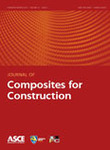Journal


Journal of Composites for Construction
Archives Papers: 295
The American Society of Civil Engineers
Please choose volume & issue:
-
Seismic Testing and Modeling of Full-Scale Substandard RC Columns Retrofitted with Sprayed GFRM with and without Basalt Mesh under High Axial Compression and Shear Demand
Abstracts:Abstract This study presents the experimental and analytical hysteretic behaviors of eight full-scale RC square and rectangular columns. The columns were designed to have different shear spans that represent: (1) a column that complies with the Turkish Government Ministry of Reconstruction and Resettlement’s ( 1975) seismic design code, Turkish Seismic Design Code (TSDC); (2) a substandard column; and (3) two sprayed glass fiber–reinforced mortar (GFRM)-retrofitted counterparts of the substandard column with and without basalt mesh. The substandard columns were designed to be subjected to relatively high shear ratios (i.e., the ratio of the shear force that corresponds to the moment capacity to shear strength of the cross section) up to 0.85 and with a high axial load-to-capacity ratio of 0.75. All columns were tested under constant axial load and reversed cyclic lateral displacement excursions. The results revealed that the columns that complied with the TSDC showed satisfactory behavior for seismic performance, and the performance of the substandard columns was extremely poor. However, the hysteretic performance of the substandard columns that were subjected to high axial stress and shear significantly improved after the proposed retrofitting. Finally, a numerical model was developed in OpenSees to reproduce the hysteresis curves of the specimens. The slip of the longitudinal bars at the column–foundation interface, strain penetration into the foundation, and buckling of the longitudinal bars in compression were accounted for in the modeling. The results are in good agreement with the experimental hysteresis curves. The performance levels of the columns are further specified, and the predictions of the current seismic codes were analyzed: (1) the European Committee for Standardization’s 2005 code, Eurocode 8: Design of structures for earthquake resistance; Parts 1–3: Strengthening and repair of buildings (EC8-3); and (2) the Turkish Government Ministry of Interior Disaster and Emergency Management Authority’s 2018 code, Turkish Building Earthquake Code (TBEC). The TBEC provided more accurate estimates of plastic rotation capacities for substandard specimens. In contrast, EC8-3 overestimated the plastic rotation capacity when shear stresses were relatively high due to lower shear span-to-depth ratios (a/d).
Hot Journals
- Risk Breakdown Matrix for Risk-Based Inspection of Transportation Infrastructure Projects
- Social Control in Outsourced Architectural and Engineering Design Consulting Projects: Behavioral Consequences and Motivational Mechanism
- 2022 Best Paper Award
- Hold-Ups and Failures in Negotiated Order: Unearthing the Nuances of Rework Causation in Construction
- Prevalence and Risk Factors for Poor Mental Health and Suicidal Ideation in the Nigerian Construction Industry
- CFRP–Cable-Stayed Bridge Hybrid with Partial Suspension and a Span Exceeding 3,000 m: Concept, Optimization, and Construction
- Impact of Wind Load Characteristics on Computed Bridge Stay-Cable Forces Used for Bridge Health Monitoring
- Weak-End and Frequency Detection of Elastically Supported Bridges by Contact Residual Response of Two-Axle Test Vehicle in a Round Trip
- Development of Performance-Based Fragility Curves of Coastal Bridges Subjected to Extreme Wave-Induced Loads
- An Analytical Model to Evaluate Short- and Long-Term Performances of Post-Tensioned Concrete Box-Girder Bridges Rehabilitated by an Ultrahigh-Performance Concrete Overlay
- Three-Dimensional Velocity Distribution in Straight Smooth Channels Modeled by Modified Log-Law
- Experimental Investigation on Flow Past Two and Three Side-by-Side Inclined Cylinders
- An Experimental Investigation of Rotor–Box Aerodynamic Interaction 1
- Modeling Gas–Liquid Flow Between Rotating and Nonrotating Annular Disks
- Entry Length Requirements for Two- and Three-Dimensional Laminar Couette–Poiseuille Flows
Advanced Materials (3,745)
- Structured Perovskite Light Absorbers for Efficient and Stable Photovoltaics
- Strategies for High‐Performance Solid‐State Triplet–Triplet‐Annihilation‐Based Photon Upconversion
- Atomic Engineering Catalyzed MnO2 Electrolysis Kinetics for a Hybrid Aqueous Battery with High Power and Energy Density
- Crystal Adaptronics: Global Performance Indices for Dynamic Crystals as Organic Thermal Actuators (Adv. Mater. 20/2020)
- Enlightening Materials with Photoswitches
Acta Astronautica (1,768)
- Mixed-integer trajectory optimization with no-fly zone constraints for a hypersonic vehicle
- Adaptive control design for active Pogo suppression of large strap-on liquid launch vehicles
- Machine learning based approach for modeling and forecasting of GPS–TEC during diverse solar phase periods
- Effect of two-dimensional micro-cavity surface on hypersonic boundary layer
- Investigation on burning behaviors of aluminum agglomerates in solid rocket motor with detailed combustion model








 User Center
User Center My Training Class
My Training Class Feedback
Feedback




